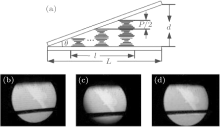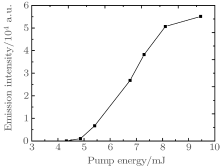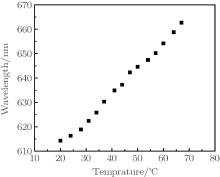†Corresponding author. E-mail: daiqin2003@126.com
*Project supported by the National Natural Science Foundation of China (Grant No. 61378042), the Outstanding Young Scholars Growth Plans of Colleges and Universities in Liaoning Province, China (Grant No. LJQ2013022), the Science and Technology Research of Liaoning Province, China (Grant No. L2010465), the Open Funds of Liaoning Province Key Laboratory of Laser and Optical Information of Shenyang Ligong University, China.
In this work, negative dielectric nematic liquid crystal SLC12V620-400, chiral dopant S811, and laser dye DCM are used to prepare dye-doped chiral nematic liquid crystal laser sample. In order to investigate temperature-tunable lasing in negative dielectric chiral nematic liquid crystal, we measure the transmission and lasing spectrum of this sample. The photonic band gap (PBG) is observed to red shift with its width reducing from 71.2 nm to 40.2 nm, and its short-wavelength band edge moves 55.3 nm while the long-wavelength band edge only moves 24.9 nm. The wavelength of output laser is found to red shift from 614.4 nm at 20 °C to 662.8 nm at 67 °C, which is very different from the previous experimental phenomena. The refractive indices, parallel and perpendicular to the director in chiral nematic liquid crystal have different dependencies on temperature. The experiment shows that the pitch of this chiral nematic liquid crystal increases with the increase of temperature. The decrease in the PBG width, different shifts of band edges, and the red shift of laser wavelength are the results of refractive indices change and pitch thermal elongation.
The molecules of chiral nematic liquid crystal (LC) are arranged in a periodic helical structure. Consequently, chiral nematic LC can be viewed as self-assembled photonic crystals (PC). Undoubtedly it has a photonic band gap (PBG) structure. The circularly polarized incident light with the same handedness as the chiral nematic LC will be reflected, and this kind of PBG is called selective reflection band. We make photonic band gap and laser dye fluorescence peaks overlap by controlling the concentration of chiral dopant. When doped with laser dye and pumped by the laser, the spontaneous emission will be suppressed within the selective reflection band. Therefore, there will be light amplification by stimulated emission of radiation at the edge of the PBG. If the gain is large enough, then the sample will output laser. From the point of view of the working principle of the laser, this kind of laser can be classified as a distributed feedback (DFB) laser and the structure of chiral nematic LC replacing the cavity mirrors.
Lasing in the dye-doped cholesteric LC was achieved for the first time in 1998.[1] Many methods have since been used to study the liquid crystal laser.[2– 4] It is well known that the pitch of chiral nematic LC is sensitive to external stimuli, such as temperature and electromagnetic field. Consequently, this character has enabled chiral nematic LC to be exploited in applications such as a tunable LC laser. During the past years, the tunable LC laser has attracted considerable interest.[5– 7] In particular, due to the easy experimental conditions, the wide tuning range, temperature-tunable LC laser has attracted widespread attention. However, most studies focus on positive dielectric liquid crystals. In these studies, almost all of the output laser wavelengths are blue-shifted with the increase in temperature.[8– 11]
In this paper, chiral dopant, negative dielectric nematic LC, and laser dye were mixed and poured into an LC cell to prepare the negative dielectric nematic LC laser sample. The tunable temperature of the sample was investigated. Surprisingly, the photonic band gap (PBG) is observed to red shift with its width reducing from 71.2 nm to 40.2 nm, and the shift of short-wavelength band edge is greater than long-wavelength band edge. The mixture turns from liquid crystal phase into isotropic phase when the temperature increases. As a result, the birefringence is reduced gradually and this is the main reason for reduced width of PBG. The PBG width decreases and different shifts of band edges are the results of refractive indices change and pitch thermal elongation. In this place, the ordinary refractive index is n⊥ and the extraordinary refractive index is n∥ . The output laser wavelength is observed to red shift from 614.4 nm at 20 ° C to 662.8 nm at 67 ° C when pumped by a Q-switched, frequency-doubled Nd:YAG laser. This is very different from previous temperature-tunable LC lasers.
In this experiment, 19.54 wt% chiral dopant (S811, SLICHEM), 1.00 wt% laser dye 4-(dicyanomethylene)-2-methyl-6-(4-dimethylaminostyryl)-4H-pyran (DCM, ALDRICH) were mixed into negative dielectric nematic LC (SLC12V620-400, SLICHEM) to prepare negative dielectric chiral nematic LC. In order to achieve planar chiral nematic LC, the prepared mixtures were capillary filled into LC cells rubbed in anti-parallel directions. The LC cell with 40 μ m thickness was chosen because a thicker LC cell has a lower threshold value. A polarizing microscope (XP-403, CAIKON) was used to check the LC molecular texture of the sample. The heating stage (JR-1010, XINCHENG) is used to control the temperature of sample. Taking into account the absorption spectrum of DCM, [7] we use a 532-nm Q-switched, frequency-doubled Nd:YAG laser as a pump source. The transmission and lasing spectrum of sample are measured by fiber spectrometer (Avaspec-2048-USB2, ARANTES). The experimental equipment is shown in Fig. 1. The pump laser beam and white light source can be adjusted to act on the samples in the same position, and the transmission and lasing spectra are superposed in the same spectral line. In this way, the position relationship between lasing wavelength and PBG can be clearly observed. To eliminate the influence of other factors, such as incident angle and exit angle, we measure the same point of the samples in this experiment. In order to obtain better detection results, an angular pump beam is used and the white light is perpendicular to the sample.
The transmission spectrums of the samples are measured at different temperatures. It can be clearly observed that the increasing temperature causes a red-shift in PBG and the width of PBG reduces from 71.2 nm to 40.2 nm, as shown in Fig. 2. However, almost all of the previous experimental phenomena are blue-shifted. Furthermore, its short-wavelength band edge moves 55.3 nm (from 609.2 nm to 664.5 nm) but the long-wavelength band edge only 24.9 nm (from 680.4 nm to 705.3 nm).
The position of PBG can be calculated by Bragg equation λ = np. Due to the birefringence, the PBG has a width of Δ λ = Δ np. In this work, n∥ > n⊥ , n∥ = ne, and n⊥ = no. Consequently, the central wavelength of the PBG depends upon the pitch p and refractive index n. For the chiral liquid crystal materials, the pitch p and refractive index n are both the function of temperature, i.e., λ (T) = n(T) × p(T).[13] The ordinary refractive index n⊥ increases slightly with temperature but the extraordinary refractive index n∥ decreases with temperature.[13] In this process, the optical anisotropy of the chiral nematic LC gradually decreases with the increase of temperature. The optical anisotropy Δ n will become zero (n∥ = n⊥ ) when the temperature reaches the N– I phase transition temperature. Taking into account the variation of LC refractive index with temperature, combined with the phenomenon of the PBG red-shift with increasing temperature, we can determine that the pitch of the chiral nematic LC used in this experiment gradually elongates with increasing temperature, i.e., dp/dT > 0. Based on the above analysis, the elongation of pitch and the variation of refractive index are the main reasons for the phenomena shown in Fig. 2.
The helical pitch of this chiral nematic liquid crystal at different temperatures can also be measured by a wedge cell. The height difference between two adjacent dislocation lines is p/2, as shown in Fig. 3(a). According to the geometrical relationship shown in Fig. 3(a), we have

We select a fixed length l from the field of view, as shown in Figs. 3(b)– 3(d). We then calculate the number of dislocation lines in the fixed width l. The number of dislocation lines is denoted by N, and it has different values at different temperatures.
The total length of the sample is L = 12.60 mm, and the thickness of spacer d is 40 μ m. The θ can be calculated by

The helical pitch at different temperatures is calculated when l = 0.5587 mm and the result is shown in Table 1. Apparently, the helical pitch is proportional to temperature.
| Table 1. The helical pitch at different temperatures. |
According to the theory of density of optical states (DOS), the DOS has the maximum value at the PBG edges.[14] In other words, the laser threshold has a minimum value at the PBG edges. The transmission and lasing spectra are observed to be superposed in the same spectral line when the white light source and pump laser act on the same position of samples at the same time. The lasing is observed at the two edges of PBG. The two lasing wavelengths are 680.4 nm and 608.6 nm, respectively, as shown in Fig. 4.
Figure 4 shows that the laser always appears in the edges of PBG. Consequently, the shift of PBG will inevitably lead to a corresponding shift of output laser wavelength. The theory of DOS has been used to simulate the distribution of the DOS with temperature, [9] and the distribution curves in different temperature are shown in Fig. 5. The simulation results show that the maximum value distribution of the DOS shifts toward longer wavelength with increasing temperature.
The laser threshold has a minimum value at the PBG edges where the DOS has the maximum value. That is to say, it is easy to produce laser radiation at the PBG edges. According to the simulation results, the output laser wavelength red-shifts with increasing temperature. The input– output curve of the sample was measured, as shown in Fig. 6. In Fig. 6, the vertical coordinate is the relative intensity of output, and the abscissa is the pump energy. In the input– output curve, there is an obvious threshold effect and the threshold is 4.3 mJ.
When pumped by a 532-nm Q-switched laser, the output laser wavelength in the short-wavelength band edge is observed to red-shift from 614.4 nm at 20 ° C to 662.8 nm at 67 ° C, as shown in Fig. 7. Apparently, this experimental result shown in Fig. 6 is consistent with the simulation results shown in Fig. 5. The plot of the laser wavelength as a function of temperature is shown in Fig. 8 for clarity where it can be seen that the laser wavelength varies monotonically.
In this paper, chiral dopant S811, laser dye DCM, and negative dielectric LC SLC12V620-400 were mixed and capillary filled into LC cells rubbed in anti-parallel directions to prepare a plannar chiral nematic LC laser sample. The temperature– tuning of the sample was investigated and different wavelength tunable properties were observed. The spectrum superposed by transmission and lasing spectra shows that the lasing will appear at the edges of PBG. The pitch of the negative dielectric chiral nematic LC increases with the increase of temperature. At the same time, n⊥ increases slightly with increasing temperature but n∥ decreases with increasing temperature. Under the combined effect of pitch elongation and refractive index change, increasing temperature causes a red-shift in PBG and the width of PBG reduces from 71.2 nm to 40.2 nm. Due to different changes of refractive index, its short-wavelength band edge moves 55.3 nm (from 609.2 nm to 664.5 nm) but the long-wavelength band edge only moves 24.9 nm (from 680.4 nm to 705.3 nm). The PBG movements cause a red-shift, from 614.4 nm to 662.8 nm, in the laser output wavelength. Therefore, a tunable laser with a tunable range of 48.4 nm is obtained.
| 1 |
|
| 2 |
|
| 3 |
|
| 4 |
|
| 5 |
|
| 6 |
|
| 7 |
|
| 8 |
|
| 9 |
|
| 10 |
|
| 11 |
|
| 12 |
|
| 13 |
|
| 14 |
|










